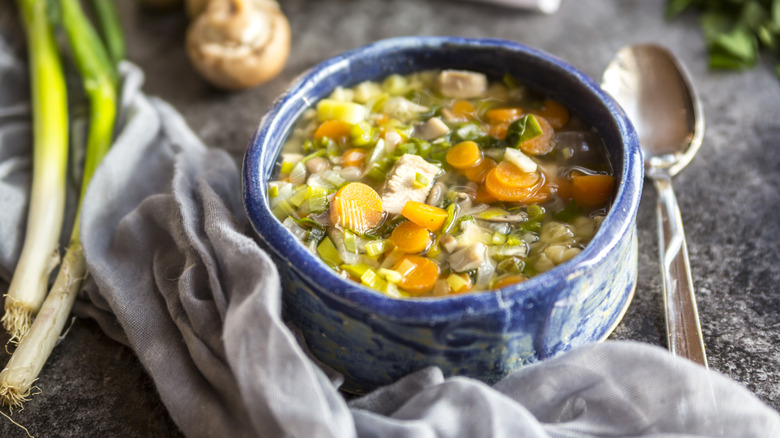Avoid One Salty Mistake When Adding Bouillon To Soup
We may receive a commission on purchases made from links.
Bouillon cubes are a culinary staple that need a place in your pantry. Small but mighty, the compact cubes effortlessly add layers of flavor. Not to mention that they're inexpensive, widely accessible, and available in a range of varieties. Foolproof as they might seem, when it comes to recipes like homemade soup, bouillon cubes must be introduced with caution — one wrong move and a bubbling batch can go from harmonious and flavorful to super salty and unpalatable.
A bouillon cube is basically a tiny block of dehydrated broth. Due to its lack of moisture, cubes have especially concentrated flavors of their key ingredients like vegetables or meats (sometimes both) and various seasonings. Of these seasonings, however, MSG and salt are particularly prominent given their incredible ability to add and enhance flavor. While dissolving a cube in water dilutes some of bouillon's intensity, a single cube still imparts significant flavor as well as sodium. As a result, this becomes problematic should you season a soup, as per usual. The solution? Taste a bouillon-laced batch, before sprinkling in extra salt.
There are no ifs, and, or buts about it: you need to give soup a taste test, prior to reaching for the salt shaker. Doing so will help you to assess flavor so that you can determine whether more salt is actually necessary, and exactly how much should be stirred in. Minor as this step seems, it will save you from throwing off balance and wrecking the recipe you spent hours preparing.
What to remember when working with bouillon cubes
Bouillon cubes are salty, even those with reduced sodium. That said, some brands are saltier than others based on their unique combo of ingredients. In fact, even flavor makes a difference. For example, meatier flavors like beef, poultry, or seafood tend to have a more richly savory profile with a saltier finish. In contrast, vegetable bouillon cubes lack the same degree of strength and, as a result, the same saltiness.
Although selecting the right bouillon cube will help you to avoid crafting a super salt-kissed soup, knowing how to introduce the ingredient is just as important. While you might be tempted to use an entire cube, we suggest starting with half. After all, you can always add more. Plus, grating in a fraction of a cube might even encourage you to amp up flavor in other ways, such as by including tomato paste, mushrooms, or bay leaves, which heighten complexity without increasing sodium levels.
Even if you taste a simmering soup frequently, occasionally, sodium can creep up on you. In which case, there are ways to remedy a recipe. One method is to add more water — even pureed beans or potatoes work — to dilute the salty flavors imparted by too much bouillon. Alternatively, incorporating citrus or sugar also neutralizes salt. However, the best solution is to prevent the sodium spike before it happens, which is why we always recommend tasting soup and seasoning it sparingly whenever bouillon cubes are involved.

